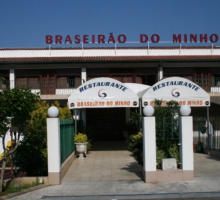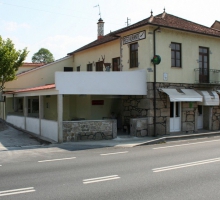Capela de Santa Luzia em Campos (Santa Luzia Chapel)
The chapel of Santa Luzia is the most important architectural jewel of Campos parish, situated in a wet land that results of the passage of Ribeiro de Regadas (Regadas Stream). It is a monument of public interest since 1982. The chapel has its origins in the Middle Ages, and was restored during the XVI and XVIII centuries. It was in the XVIII century that it received the two spaces
that still remain, as well as the disconnection existing between the two walls, a factor that was also caused by the water infiltration that recently obliged their reinforcing and the cap stone of part of the churchyard. In this chapel, we can still find some of the sixteenth century origins, as the way of joining the stones used in the construction, the modillions of the present chancel, the walled door with pointed arch on the north side, in the two prominent buttresses in the middle of the construction and, naturally, on the main door. Standing in a detached place, there is a shield with the coat of arms of the Porto-Carreiros family. However, the importance of the chapel is not in its architectural structure. The gothic frescos that exist in the interior have more visibility as patrimony than the tombs we can find there and which are the evidence of a number of burials throughout the years. The inscription engraved in the façade that celebrates the foundation of the chapel and which is a testimony of D. Afonso Henriques as king, also deserves attention. Some of the many questions about this chapel were left to the end. In this place there would have been a female convent named Mosteiro de Santa Maria de Valbôa, (Santa Maria de Valbôa Monastery) founded by the Senhores da Torre da Silva, county of Valença, according to the Corografia Portuguesa do P.e Carvalho (Portuguese Chorography by Priest Carvalho), work of the early eighteenth century. This Monastery is documented in the thirteenth century, according to the Inquiries made in Reboreda parish: Nuno Suariz created “abatissa de Valle bona”, there is no doubt about it. There are doubts about the localization of the monastery, but it is certain that the fifteenth century chapel has incorporated stones from another construction – in the outside of the chancel there is an engraved cushioned ashlar in roman style – and its construction is intimately connected with the water cult. The chapel was dedicated to Santa Luzia, a saint believed to have the power of healing those who suffer from sight. Near the top north of the chancel there is an old spring that, it is said, has curative properties. It is not difficult to compare the two facts. What is difficult is to prove the presence of the monastery in this place. In the inside there are two tombs set in their arcosolium that, according to the printed symbols, belong to the Meiras family. To them we should join the already mentioned frescos and a baroque carved small altar.
Location: Vila Nova de Cerveira
The chapel of Santa Luzia is the most important architectural jewel of Campos parish, situated in a wet land that results of the passage of Ribeiro de Regadas (Regadas Stream). It is a monument of public interest since 1982. The chapel has its origins in the Middle Ages, and was restored during the XVI and XVIII centuries. It was in the XVIII century that it received the two spaces
that still remain, as well as the disconnection existing between the two walls, a factor that was also caused by the water infiltration that recently obliged their reinforcing and the cap stone of part of the churchyard. In this chapel, we can still find some of the sixteenth century origins, as the way of joining the stones used in the construction, the modillions of the present chancel, the walled door with pointed arch on the north side, in the two prominent buttresses in the middle of the construction and, naturally, on the main door. Standing in a detached place, there is a shield with the coat of arms of the Porto-Carreiros family. However, the importance of the chapel is not in its architectural structure. The gothic frescos that exist in the interior have more visibility as patrimony than the tombs we can find there and which are the evidence of a number of burials throughout the years. The inscription engraved in the façade that celebrates the foundation of the chapel and which is a testimony of D. Afonso Henriques as king, also deserves attention. Some of the many questions about this chapel were left to the end. In this place there would have been a female convent named Mosteiro de Santa Maria de Valbôa, (Santa Maria de Valbôa Monastery) founded by the Senhores da Torre da Silva, county of Valença, according to the Corografia Portuguesa do P.e Carvalho (Portuguese Chorography by Priest Carvalho), work of the early eighteenth century. This Monastery is documented in the thirteenth century, according to the Inquiries made in Reboreda parish: Nuno Suariz created “abatissa de Valle bona”, there is no doubt about it. There are doubts about the localization of the monastery, but it is certain that the fifteenth century chapel has incorporated stones from another construction – in the outside of the chancel there is an engraved cushioned ashlar in roman style – and its construction is intimately connected with the water cult. The chapel was dedicated to Santa Luzia, a saint believed to have the power of healing those who suffer from sight. Near the top north of the chancel there is an old spring that, it is said, has curative properties. It is not difficult to compare the two facts. What is difficult is to prove the presence of the monastery in this place. In the inside there are two tombs set in their arcosolium that, according to the printed symbols, belong to the Meiras family. To them we should join the already mentioned frescos and a baroque carved small altar.
Location: Vila Nova de Cerveira




